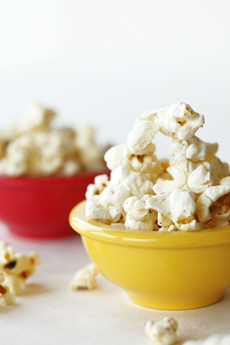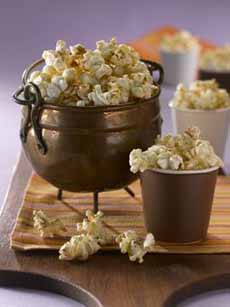

Bowls of fresh-popped popcorn kernels. Photo by Katharine Pollak | THE NIBBLE.
|
MELODY LAN is a member of THE NIBBLE editorial staff. |
|
July 2006
Last Updated October 2018
|
 |
What Makes Popcorn Kernels Pop
Page 2: The Science Of Popcorn
CAPSULE REPORT: This is Page 2 of a four-page article on the history of popcorn, up through modern popcorn flavors and recipes. Click on the black links below to visit other pages.
How Corn Kernels Become Popcorn
Not all corn can be popcorn: there are six types of corn commonly grown, and while some while some wild types will pop, only popcorn pops on command. Popping corn is a special type of maize that puffs up when it is heated in oil or by dry heat. While the strain was first developed by pre-columbian Native Americans, special varieties have been developed by agriscientists that improve popping yield.
As with all cereal grains, each kernel of popcorn contains a certain amount of moisture in its starchy endosperm. Unlike most other grains, the outer hull of the popcorn kernel is thick and impervious to moisture.
- Boiling. As the kernel is heated past the boiling point, water in the kernel begins to turn to steam, generating an internal pressure of about 9 atm. In kernels of other grains, this steam escapes through the hull as fast as it forms, but in the tightly sealed popcorn kernel, the steam is held in by the hull. The pressure starts to build until the hull suddenly ruptures, causing a small explosion.
- Bursting. The starch in the endosperm (the core) bursts to about 40 times its original size, turning the kernel inside out. The average popping temperature for popcorn is around 347°F.
- Airy. Because the moisture is evenly distributed throughout the starchy endosperm, the sudden expansion turns the endosperm into an airy foam which gives popcorn its unique texture.
|
|

Kettle corn is the fastest-growing flavor in the U.S. It is sweet and salty. In the 18th and 19th centuries, it was made in a cast iron kettle; hence the name. |
- Old Maids. Kernels which do not pop, known as “old maids,” are believed to have not enough moisture to create enough steam for an explosion; or perhaps they have a leaky hull.
The ideal popcorn kernel contains approximately 14% moisture. Without enough water, the kernel will not pop at all, which is why old kernels don’t pop.
Popcorn kernels should be kept in tightly sealed containers to prevent them from drying out.

|





